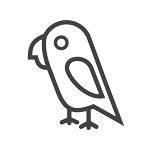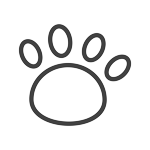
Alaskan Malamute: The Ultimate Guide to This Majestic Breed
There’s something about an Alaskan Malamute that just stops people in their tracks. Maybe it’s the sheer size, the wolf-like looks, or that thick, fluffy coat that practically screams “cuddle me”—but make no mistake, these dogs are more than just head-turners.
Originally bred to haul heavy sleds across icy Alaskan terrain, the Alaskan Malamute is one of the oldest Arctic sled dog breeds. And with that ancient lineage comes strength, stamina, and a surprisingly playful personality. They’re loyal, independent, and full of character—but they’re definitely not the right match for every home.
If you’re considering adding one to your family (or already have a fuzzy giant ruling your household), this guide is your go-to for everything Alaskan Malamute dog. From what to expect with a Malamute puppy to how they compare to Huskies, we’re diving deep into temperament, grooming, feeding, and more.
Oh—and because owning a breed like this in sunny Australia comes with a few extra challenges, we’ll also include tips and must-have gear to help your Malamute live its best life down under (like a cooling mat from PaWz).
The Origins of the Alaskan Malamute
Before they were curling up on plush beds in modern homes, Alaskan Malamutes were working side-by-side with Indigenous peoples in some of the harshest climates on Earth. Their roots trace back thousands of years to the Mahlemut Inupiat people of northwestern Alaska, who developed the breed for one clear reason: survival.
These dogs weren’t just pets—they were essential partners. Malamutes hauled heavy sleds, hunted alongside humans, and even helped guard camps from predators. Unlike faster sprinting sled dogs like the Siberian Husky, the Malamute was bred for power over speed—pulling heavy loads over long distances at a steady, enduring pace.
Built for Strength, Not Speed
If you’re picturing a dog that could tow a small ute, you’re not far off. The Malamute was never meant to win races; they were designed to move weight. That’s why they’re so heavily boned, broad-chested, and, well, massive.
Their thick double coat? A necessity for withstanding sub-zero temperatures. Their independent streak? A reflection of generations working in the wild, where decision-making often kept them (and their people) alive.
Not Just a Snow Dog
Despite being Arctic specialists, Malamutes found their way into modern history too. They served during World War II, helped with Antarctic expeditions, and have been featured in numerous films and TV shows thanks to their wolf-like appearance and noble bearing.
And yet, at heart, they remain the same steadfast, hard-working, deeply bonded dogs the Mahlemut people first bred centuries ago.
Alaskan Malamute Personality and Temperament

If you think the Alaskan Malamute dog is just a big, fluffy teddy bear, you’re half right. They’re incredibly affectionate, especially with their humans, but they’re also intelligent, wilful, and fiercely independent—which can make them a bit of a handful if you’re not prepared.
Affectionate, but Not Clingy
Unlike Velcro breeds that follow you from room to room, Malamutes are quite happy to do their own thing. They love being near their family but don’t constantly demand attention. That said, they’re deeply loyal—once you earn their trust, they’ll be your mate for life.
And while they’re not exactly “guard dogs,” their imposing size and confident stance are usually enough to make strangers think twice.
Pack-Oriented with a Side of Sass
This is a breed that thrives in a pack dynamic, which means they do best when there’s a clear leader—you. Without one, they’ll likely try to take the top spot (and good luck arguing with a 40kg snow dog once they’ve made up their mind).
They also have a wicked sense of humour. Malamutes are known for testing boundaries, giving side-eye when they’re not impressed, and “talking back” with those famous woo-woo vocalisations. You’ll never forget the first time your dog argues with you… in full sentences.
Social, But Not Always a Fan of Other Dogs
Many Malamutes are friendly with people, but their interactions with other dogs can be unpredictable, especially dogs of the same sex. Their strong prey drive can also make them unsafe around small pets, like cats or rabbits, unless they’ve been raised together and carefully socialised.
Natural Confidence
Malamutes carry themselves with a calm, steady presence. They’re not usually hyper or anxious, but they can be stubborn and aren’t the type to obey “just because you said so.” Training takes consistency, patience, and a good sense of humour.
Appearance, Colours & Natural Markings
There’s no mistaking an Alaskan Malamute dog when you see one. With their massive build, wolf-like features, and striking coat patterns, they often look like they’ve wandered straight out of a snow-drenched fairy tale. But beyond their looks, there’s a lot of structure and purpose behind every feature.
Size & Build: Muscle Meets Fluff
Malamutes are large, powerfully built dogs. Adult males typically weigh 38–43 kg, with females slightly lighter at 34–38 kg. They stand between 58–63 cm at the shoulder, but it’s their heavily boned frame and broad chest that truly makes them stand out.
Everything about their body is made for endurance—big paws for snow, a strong back for pulling, and a wide head for better heat retention. You’ll feel the sheer weight of them when they flop down beside you like a furry sack of bricks.
Thick Double Coat
That plush, thick coat is no joke. It’s made up of:
-
Dense, woolly undercoat (up to 5cm thick)
-
Coarse outer guard hairs that help repel dirt and moisture
They “blow” this coat twice a year, and when that happens—get ready. It’s like a snowstorm hit your living room. Regular grooming (more on that later) is an absolute must.
Classic Colours & Markings
Most Malamutes sport a beautiful mix of:
-
Grey and white
-
Black and white
-
Red and white
-
Sable and white
-
Or even a stunning all-white
Their faces often have distinctive markings, including:
-
A cap or mask over the eyes
-
A white blaze down the snout
-
Bar-shaped eyebrow patches
These markings are not just for show—they’re unique to each dog and can be as recognisable as a fingerprint.
That Signature Tail
You’ll notice the Malamute’s heavily furred tail curls over their back like a fluffy plume. It’s not just pretty—when curled over the nose during sleep, it helps conserve heat in freezing temperatures. Yes, even their tail is built for survival.
Alaskan Malamute Puppies – What to Know Early On

There’s nothing quite like an Alaskan Malamute dog puppy. With their oversized paws, bright eyes, and cheeky personalities, they’ll melt your heart—right before chewing your shoes, digging up your lawn, and outsmarting your every command. Raising a Malamute pup is rewarding, but it’s not for the faint-hearted.
From Fluffball to Powerhouse
Malamute puppies grow fast and grow big. Don’t be fooled by the soft fur and wobbly legs—by six months, many pups are already pushing 30kg and testing boundaries like tiny, fuzzy teenagers.
Their bones and joints are still developing during this time, so it’s crucial not to over-exercise them. Long hikes or stair-climbing can wait—what they need most is structured play, soft surfaces, and a safe space to rest. A supportive orthopaedic dog bed from PaWz is a smart investment early on, helping prevent future joint issues.
Early Socialisation is Essential
Malamutes can grow into strong-willed, territorial adults if not properly socialised. That means:
-
Meeting all sorts of people (kids included)
-
Spending time with other friendly dogs
-
Exposure to sounds, surfaces, and new places
The more variety they experience early, the more adaptable and relaxed they’ll be later on.
Training Starts on Day One
Forget waiting until they’re “settled”—Malamute puppies are born thinkers. If you don’t teach them the rules, they’ll make up their own. Start with:
-
Name recognition
-
Toilet training (stock up on absorbent dog training pads)
-
Basic commands like sit, stay, and come
-
Leash manners—they’re strong even as babies!
Keep training sessions short, positive, and consistent. They respond well to food, praise, and firm but fair leadership.
Mental Stimulation is a Must
Bored Malamute pups are destructive Malamute pups. Think puzzle feeders, frozen treat toys, and safe chews. They love a challenge, and keeping their brain busy will save your shoes, walls, and sanity.
Alaskan Malamute Lifespan & Common Health Conditions

Big dogs often come with shorter lifespans—but thanks to their hardy lineage, the Alaskan Malamute typically enjoys a longer run than many breeds of its size. On average, a healthy Malamute can live between 10 to 14 years, especially with proactive care and the right lifestyle.
Top Health Issues in Alaskan Malamutes
While they’re generally robust, there are a few health conditions that crop up more commonly in this breed:
-
Hip Dysplasia
A genetic joint disorder where the hip socket doesn’t fit the thigh bone properly. Over time, it can cause pain, stiffness, and arthritis. Regular vet checks and maintaining a healthy weight are key. -
Hypothyroidism
This is a hormone imbalance where the thyroid gland doesn’t produce enough thyroid hormone. It can lead to weight gain, lethargy, hair thinning, and skin issues. It’s manageable with medication once diagnosed. -
Inherited Polyneuropathy
A rare neurological condition seen in some Malamutes, causing muscle weakness, difficulty walking, and reduced coordination. While not always fatal, it significantly affects mobility and quality of life. -
Cataracts & Progressive Retinal Atrophy (PRA)
Eye issues can appear as early as middle age. Regular eye checks are important, especially if you notice cloudiness or clumsiness in your Mal. -
Gastric Torsion (Bloat)
Like many deep-chested breeds, Malamutes are at risk for bloat, a life-threatening condition where the stomach twists. Feeding smaller meals, avoiding vigorous exercise after eating, and using a slow-feeder bowl can help reduce the risk.
How to Promote Longevity Naturally
Want your Malamute to live a long, happy life? Focus on:
-
A balanced, high-quality diet rich in joint-supportive nutrients like Omega-3 and glucosamine
-
Maintaining a healthy weight (less strain on joints = longer mobility)
-
Regular vet checkups and health screenings
-
Daily exercise tailored to their age and ability
-
Providing a cool, supportive sleep space like a PaWz orthopaedic cooling bed, especially in Aussie heat
With the right care, your Malamute won’t just live long—they’ll thrive naturally, with that signature sparkle in their eye well into their golden years.
Feeding & Diet: What Fuels an Alaskan Malamute
Feeding an Alaskan Malamute dog isn’t just about filling up a bowl—it’s about fuelling a powerhouse. With their large frames and active lifestyles, Malamutes need a balanced diet that supports energy, joint health, and digestion.
But beware—they’re also prone to weight gain if overfed or under-exercised. That thick coat hides extra kilos very well, so you’ll need to be on top of their nutrition from day one.
How Much Should a Malamute Eat?
An adult Malamute typically needs around 1,500 to 2,200 calories per day, depending on their age, weight, activity level, and whether they’ve been desexed. That’s about:
-
3 to 4 cups of premium dry food daily (split into two meals)
-
Or a balanced raw or fresh diet in appropriate portions
Puppies need more frequent meals—usually 3 to 4 times a day until they’re about 6 months old.
Best Diet Options
There’s no one-size-fits-all, but here are some healthy feeding choices:
-
High-protein kibble: Look for meat as the first ingredient, with no fillers or artificial preservatives. Choose a large-breed formula with joint support.
-
Raw or BARF diet: Some owners prefer feeding raw meat, bones, and organ blends for a more natural diet. If you go this route, consult a vet or canine nutritionist to ensure it’s balanced.
-
Fresh-cooked meals: Think human-grade pet food subscriptions or home-prepped meals with lean meat, rice, and veggies.
Whichever you choose, make sure it includes:
-
Omega-3 fatty acids (for coat and joint health)
-
Glucosamine and chondroitin (for large-breed joint support)
-
Limited carbs and low grains (to prevent bloating and weight gain)
Foods to Avoid
Malamutes may have stomachs of steel when it comes to snow and dirt, but some foods are off-limits:
-
Grapes and raisins (toxic to kidneys)
-
Onion and garlic (damages red blood cells)
-
Chocolate and caffeine
-
Cooked bones (can splinter and cause blockages)
-
Too many treats (can throw off their diet and weight)
Top Feeding Tips
-
Use a slow feeder to prevent gulping and reduce bloat risk
-
Feed in a calm environment—no post-dinner zoomies
-
Fresh water should always be available, especially in warm weather
-
Stick to a schedule—Malamutes love routine
Grooming Needs & Coat Care: Living with All That Fluff

There’s no sugar-coating it—owning an Alaskan Malamute means committing to a lifetime of grooming. That glorious double coat isn’t just for show—it’s functional, seasonal, and downright intense. If you're not up for vacuuming daily or brushing until your arms ache, this might not be the breed for you.
The Double Coat Explained
Malamutes have a dense, two-layered coat:
-
Undercoat: Soft, woolly, and thick—this is what insulates them in sub-zero temps.
-
Topcoat: Coarse guard hairs that repel dirt, moisture, and snow.
Together, it creates a weatherproof barrier—but it also means year-round shedding and epic coat-blowing events twice a year, usually in autumn and spring. Picture this: tumbleweeds of fluff drifting across your living room like it’s a snowstorm indoors.
How Often Should You Groom?
-
Brushing:
• 2–3 times per week normally
• Daily during shedding season (trust us, you’ll know when it starts)
Use a slicker brush and an undercoat rake to reach the base of the coat. Matting is common around the tail, ears, and haunches, especially in humid weather. -
Bathing:
Only once every 6–8 weeks, unless they roll in something foul (which they probably will). Use a gentle, dog-specific shampoo and rinse thoroughly—that thick coat holds suds like a sponge. -
Drying:
Air drying can take ages and increase the risk of hot spots. Use a high-velocity pet dryer if you can—or lay them on a highly absorbent cooling mat (like the ones from PaWz) in warm weather to help dry them out and prevent overheating. -
Nail trimming:
Every 3–4 weeks. Their nails don’t always wear down naturally due to soft backyard surfaces. -
Ear & dental care:
Check ears weekly for redness, wax, or smell. Brush teeth 2–3 times a week with dog-safe toothpaste.
Grooming Reality Check
This isn’t a low-maintenance breed. Grooming isn’t optional—it’s essential for their health, hygiene, and comfort. But here’s the upside: grooming is a fantastic bonding activity, and many Malamutes genuinely enjoy the attention (as long as you start early and keep it positive).
Training & Exercise: Keeping Your Malamute’s Body and Brain Busy
If there’s one thing you should never underestimate about an Alaskan Malamute, it’s their energy. These dogs were bred to haul heavy sleds for hours—so that stamina? It’s built in. Without daily physical and mental challenges, a Malamute will find their own “job”… and you probably won’t like what they pick.
Daily Exercise Needs
Your average walk around the block won’t cut it. A healthy adult Malamute needs:
-
At least 1.5–2 hours of exercise per day
-
A mix of on-lead walks, off-lead play (in secure areas), and mental stimulation
Ideas to burn off energy:
-
Hiking or bushwalks (weather permitting)
-
Dog weight-pulling or backpack walks
-
Scent games or structured play
-
Tug-of-war, flirt poles, or long-line recall games
Living in Australia? Invest in early morning or late evening walks during summer—and always have access to shade, fresh water, and a dog cooling mat to help them regulate their temperature.
Mental Stimulation: A Must
A bored Malamute is a chaotic Malamute. They’re too smart to sit idle, and too wilful to do tricks “just because.”
Keep their brains busy with:
-
Puzzle toys and treat dispensers
-
Interactive feeders (bonus: helps slow down gulpers!)
-
Nose work and scent trails
-
Obedience training with rotating commands
Rotate toys every few days to keep them interested.
Training Tips: Start Early, Stay Consistent
Malamutes are incredibly intelligent—but they’re also independent thinkers. If you want a dog who’ll blindly follow every command… this ain’t it.
But they do respond well to:
-
Positive reinforcement (treats, praise, play)
-
Short, focused sessions (5–10 minutes max)
-
Consistency—mixed messages confuse them
-
Firm, calm leadership—they need to respect you
Avoid harsh corrections or punishment—they’ll tune you out or push back. Think of training as a negotiation with a very fluffy, very clever toddler.
Recall & Off-Lead Warnings
Here’s the honest truth: Malamutes are notorious for unreliable recall. Their prey drive is strong, and if they see a rabbit or possum… they’re gone. Unless you’ve nailed recall through serious training (and even then, it’s risky), keep them in secure, fenced areas when off-lead.
Malamutes with Children & Other Pets: The Family Fit Check
The Alaskan Malamute dog may look like a gentle bear and act like a goofball with their humans, but when it comes to small children or other pets, things can be a bit more nuanced. They're generally loyal and affectionate, but every interaction needs to be guided with care—especially given their size and instincts.
With Children: Gentle but Strong
Malamutes are typically very good with children—especially older ones who understand how to respect a dog’s space. They’re not aggressive by nature, but their size alone can be overwhelming for toddlers or small kids. One accidental bump during zoomies and your little one could end up face-first on the floor.
Tips for a safe Malamute-kid combo:
-
Always supervise playtime
-
Teach kids how to approach and interact respectfully
-
Show them how to read dog body language (tail up ≠ happy!)
Malamutes are incredibly tolerant, but they don’t love being teased, hugged tightly, or having their tails yanked. If your child can understand boundaries, the bond can be beautiful.
With Other Dogs: Case by Case
This is where things get trickier. While Malamutes are social dogs, they can be selective with other canines—especially those of the same sex. Their pack mentality and dominance tendencies mean that they often do better with:
-
Dogs of the opposite sex
-
Neutered or spayed companions
-
Dogs with calm, non-confrontational energy
Early socialisation and consistent training are non-negotiable if you want them to get along with others.
Important: They’re not great candidates for off-leash dog parks unless they’ve been impeccably trained and socialised. Rough play can escalate quickly with a breed this strong.
With Cats & Smaller Animals: Use Caution
This might sound harsh, but here’s the truth: Malamutes have a strong prey drive, and many can’t be trusted around cats, rabbits, guinea pigs, or chooks. There are exceptions—especially if they’ve been raised together—but supervision is always required.
You can train them to be tolerant, but you can’t train away instinct entirely. And when a 40kg dog decides to chase, there’s no stopping them.
Is the Alaskan Malamute the Right Dog for You?
Let’s be real: the Alaskan Malamute isn’t your average pet. They’re breathtaking, bold, and incredibly loyal—but they’re also a lot of dog. If you’re thinking about welcoming one into your home, it’s important to know what you’re signing up for.
Ideal for Owners Who...
- Are active and outdoorsy (or at least willing to be)
- Have a large, secure yard with high fencing
- Understand canine behaviour and positive reinforcement training
- Have time each day for exercise, grooming, and enrichment
- Don’t mind a bit (okay, a lot) of fur on everything they own
- Can keep them cool in warm Aussie climates—cooling mats, shaded areas, aircon, you name it
Probably Not the Best Match If You...
- Live in a small apartment or hot climate without cooling solutions
- Want an off-lead, super-obedient dog
- Can’t dedicate time every day to grooming and training
- Have small pets like cats, rabbits, or chickens
- Prefer a low-maintenance or quiet breed
A Dog That Thrives on Purpose
Malamutes are working dogs at heart. They’re at their happiest when they have a job to do—whether that’s pulling a cart, hiking a trail, or just playing scent games in the backyard. If you give them what they need, they’ll give you loyalty, companionship, and years of adventure in return.
They may test your patience, outsmart you at times, and leave you buried in fur… but for the right person, a Malamute is the ultimate mate.
Ready to take the plunge? Whether you're prepping for an Alaskan Malamute puppy or upgrading life for your full-grown floof, PaWz has you covered. From supportive orthopaedic beds to cooling mats that help beat the Aussie heat, our products are designed with big, intelligent breeds like the Malamute in mind.
Make your home Malamute-ready with gear that keeps them comfy, enriched, and naturally thriving—because a dog this majestic deserves the best.










Leave a comment